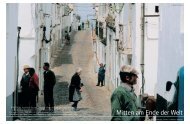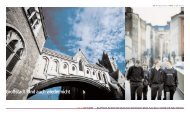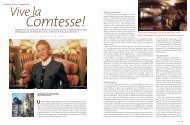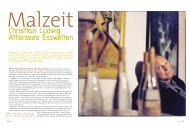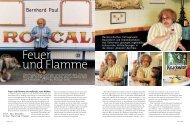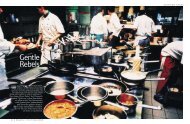Wintry Water Worlds
Wintry Water Worlds
Wintry Water Worlds
Create successful ePaper yourself
Turn your PDF publications into a flip-book with our unique Google optimized e-Paper software.
<strong>Wintry</strong> <strong>Water</strong> <strong>Worlds</strong><br />
LIKE SO MANY OTHER ASPECTS OF VIENNESE LIFE, THE BATHS<br />
<strong>Wintry</strong> <strong>Water</strong> <strong>Worlds</strong><br />
WERE LONG ASSOCIATED WITH QUESTIONS OF AESTHETICS<br />
AND STYLE. IT’S TRUE AGAIN TODAY, BUT THE BATHS<br />
THEMSELVES, UNFORTUNATELY, HAVE BECOME INCREASINGLY RARE.<br />
By Anita Ericson / Photos Roland Unger
The heart of the Amalienbad is the huge indoor pool./Mittelpunkt des Amalienbades ist eine großzügige Schwimmhalle.<br />
The fabulous mosaics in the Women’s Sauna were created in 1926./Die Mosaiken der Damensauna sind originale Meisterstücke aus 1926.<br />
Vienna’s Amalienbad, a seductive temple of bathing culture and luxurious oasis<br />
of recreation, is currently celebrating its 75th anniversary.<br />
Das Wiener Amalienbad feierte gerade sein 75-jähriges Jubiläum.<br />
Es ist heute noch ein verführerischer Tempel der Badekultur,<br />
eine luxuriöse Oase der Entspannung.<br />
<strong>Wintry</strong> <strong>Water</strong> <strong>Worlds</strong>
<strong>Wintry</strong> <strong>Water</strong> <strong>Worlds</strong><br />
The Jörgerbad is Vienna’s oldest bath. When it was opened in 1914, it was the first real<br />
bathing establishment for the common people.<br />
Das Jörgerbad ist das älteste Bad in Wien. Bei seiner Eröffnung,<br />
1914, war es die erste richtige Schwimmanstalt für das einfache Volk.<br />
Without a doubt the Amalienbad is<br />
Vienna’s most beautiful indoor swimming<br />
pool and bathing establishment. More than<br />
simply a place for recreation or cleanliness,<br />
the Amalienbad is a seductive temple of<br />
bathing culture, a luxurious oasis of relaxation.<br />
That’s what it was when it opened, and<br />
despite the course of human progress, that’s<br />
what it remains today. Paradoxically it was<br />
built not for a well-heeled upper class that<br />
would have taken its splendour for granted,<br />
but rather for simple workers for whom the<br />
opposite was true. This year the Amalienbad<br />
is quietly celebrating its 75 th anniversary,<br />
but when it was officially opened in July<br />
1926, the Social Democrats staged a public<br />
festival to celebrate this “symbol of the advancement<br />
of the working class to a new and<br />
higher culture”.<br />
Two architects from Vienna’s Department<br />
of Municipal Buildings, Otto Nadel and Karl<br />
Schmalhofer, built the Amalienbad between<br />
1923 and 1926 in the working-class district<br />
of Favoriten. On the outside, the nakedness<br />
of the monumental statues hints at the purpose<br />
of the building, which otherwise fascinates<br />
by virtue of its sheer size and severity.<br />
But inside, the magnificence of 1920s design<br />
unfolds, crowned by the ceramic works of the<br />
Schwadron brothers. Although much of it<br />
was destroyed during the Second World War,<br />
the Amalienbad still contains a generous<br />
Loads of light, lots of space and lovely artistic details are an invitation to jump right in.<br />
Viel Licht, viel Raum und künstlerische Details animieren zum Sprung ins kühle Nass.<br />
83
84<br />
The Roman Baths in Baden are now a thermal indoor pool, combining older elements with modern technology./Die Römertherme in Baden bei Wien wurde zu einem Hallenthermalbad<br />
<strong>Wintry</strong> <strong>Water</strong> <strong>Worlds</strong><br />
VIENNA’S BATHS<br />
Most of Vienna’s indoor swimming pools<br />
are owned by the city, and most of them are<br />
small, neighbourhood baths from the 1970s.<br />
Only a few of the older baths, or fragments<br />
of them, have been preserved.<br />
Amalienbad<br />
Reumannplatz 23, 1100 Vienna<br />
Large indoor swimming pool with divingplatform,<br />
also large sauna. Open daily except<br />
Monday, at least between 9 AM and 6 PM,<br />
sauna hours vary,<br />
admission from ATS 25/EUR 1.82.<br />
Jörgerbad<br />
Jörgerstrasse 42–44, 1170 Vienna<br />
Indoor swimming pool with bright,<br />
airy pool area, diving-platform and large<br />
children’s slide. Sauna as well. Open<br />
daily except Monday, at least between<br />
9 AM and 6 PM, sauna hours vary,<br />
admission from ATS 25/EUR 1.82.<br />
Tropicana Dianabad<br />
Lilienbrunngasse 7–9, 1020 Vienna<br />
Children’s adventure bath with tropical<br />
air and water temperatures. Original<br />
Jugendstil mosaics in the sauna area.<br />
Open daily from 10 AM to 10 PM (Sunday<br />
to 8 PM), admission from ATS 100/EUR 7.27.<br />
WELLNESS PARK OBERLAA<br />
The suburb of Oberlaa lies on<br />
Vienna’s southern city limits and<br />
has long been known for its sulphur<br />
thermal springs. Since 1974 there<br />
have been a thermal bath and a spahouse.<br />
With the opening in 1995 of<br />
the new Wellness Park, Oberlaa<br />
dusted off its image and began<br />
addressing a younger clientele.<br />
www.oberlaa.at<br />
Oberlaa Wellness Park<br />
Kurbadstrasse 16, 1100 Vienna<br />
Fitness and sports areas plus relaxing<br />
bath area. The Thermarium offers<br />
a choice of Ottoman Bath (steambath),<br />
Seraglio Bath (with various<br />
curative mud treatments), Laconium,<br />
Aroma Grotto, Kneipp Circuit, Whirlpool<br />
and, of course, Finnish Sauna.<br />
Thermarium open daily from 10 AM<br />
to 9:30 PM, Monday to Friday until<br />
10:30 PM. Admission costs<br />
ATS 230/EUR 16.71.<br />
amount of nostalgic glory. During its renovation 20 years<br />
ago, as much of the historical substance as possible was<br />
saved, but even more was reconstructed, and additions<br />
were made in the original style.<br />
The central feature is the grand, almost symmetrical indoor<br />
pool, with the surrounding building soaring two storeys<br />
above it to provide a feeling of spaciousness. The milky glass<br />
ceiling, which arches gracefully to a height of 14 metres<br />
above the pool, could formerly be opened but now remains<br />
permanently closed. Details such as the cubicle doors<br />
of honey-coloured wood in the upper two storeys,<br />
the colourful tiles in the children’s pool, and the elaborate<br />
and artistic ironwork combine in harmonious unity. Like<br />
the entrance hall with its intricate mosaics on the floor<br />
and walls, the warm-water pool in the – sorry gentlemen –<br />
women’s sauna is a true masterpiece. The green-blue-yellow<br />
tiled columns with their three-dimensional flowers and<br />
wreaths are a real eye-catcher.<br />
With room for 1,300 visitors, the Amalienbad was one<br />
of the largest baths in Europe when it opened, and it also<br />
featured the latest technology. With a 10-metre diving platform,<br />
a pool length of 33 metres and sinking spectator<br />
stands, it was well equipped for athletic competitions.<br />
But there were also facilities that up to that time would have<br />
been found only at spas that catered for the wealthy: steam,<br />
hot-air, and medicinal baths, hairdressers and masseurs,<br />
manicures and pedicures. The Amalienbad was the logical<br />
complement to the bathless public housing being built in<br />
what was then known as Socialist or “Red” Vienna.<br />
umgebaut, bei dem alte Elemente geschickt mit neuer Technik kombiniert wurden.<br />
The forerunner of the Amalienbad was the Jörgerbad,<br />
Vienna’s oldest indoor swimming pool still in operation. The<br />
pool area is considerably smaller but offers just as much<br />
light and space as the Amalienbad. When the sun is shining,<br />
the bright orange tiles begin to glow, contrasting shimmeringly<br />
with the sky-blue water. Unfortunately only a few remaining<br />
details bear the artistic signature of the Wiener<br />
Werkstätte style in which the Jörgerbad was originally<br />
decorated by its architect, Friedrich Jäckel.<br />
When it opened in 1914, the Jörgerbad was the first real<br />
bath for ordinary people in Vienna. Previously there had<br />
been only the Volksbäder, the “people’s baths”, which were<br />
built solely for hygienic purposes. They had become necessary<br />
as the city’s population grew explosively in the second<br />
half of the 19 th century and the living conditions in hastily<br />
built cheap housing became increasingly catastrophic. The<br />
Volksbäder had showers and tubs and were designed to<br />
serve masses of people, and the new indoor swimming<br />
pools had a similar function as well. Public showers continued<br />
to be important until the late 1970s, and a few,<br />
mostly older people still use them today. Because the huge<br />
crowds often reduced water pressure and the flow of<br />
water in the showers to a minimum, they were nicknamed<br />
Tröpferlbäder (“trickle baths”).<br />
One need only to look a bit further back in the history<br />
of the Vienna baths to find the upper classes: the Dianabad,<br />
which first opened in 1810, was designed for the pleasure<br />
of the well-heeled. In the 1840s the architects Ludwig<br />
Förster and Karl von Etzel built an indoor swimming pool,<br />
your business<br />
is our business<br />
Österreichs führende und freundlichste<br />
Hotelgruppe heißt Sie herzlich willkommen!<br />
➢ 15 Hotels in Wien<br />
➢ 7 Hotels in St. Pölten, Linz, Salzburg, Graz<br />
und Villach<br />
➢ 4 erholsame und sportliche Resorthotels<br />
Ankommen und sich wohlfühlen!<br />
Genießen Sie unser professionelles Business- und<br />
Konferenzservice:<br />
➢ speziell ausgestattete Business-Zimmer<br />
➢ ausgezeichnetes Preis-/Leistungsverhältnis<br />
➢ rasche und kompetente Reservierung<br />
➢ Power Breakfast – Frühstücksbuffet<br />
➢ Konferenz- und Seminareinrichtungen<br />
für 10 bis 400 Personen<br />
www.austria-trend.at<br />
service inside<br />
austria trend hotels & resorts<br />
Dresdner Straße 81 – 85 A-1200 Wien<br />
Tel.: 0043/1/588 00-680 Fax: 0043/1/588 00-699<br />
e-mail: office@austria-trend.at http://www.austria-trend.at<br />
service to feel well
86<br />
EXCURSION TO BADEN<br />
Baden is a pretty little spa town with<br />
pronounced Biedermeier character<br />
about 25 kilometres south of Vienna.<br />
Its entire history and development are<br />
based on the healing powers of its<br />
thermal springs, and it is thus unsurprising<br />
that the baths are in the heart<br />
of town. www.baden-bei-wien.at<br />
Römertherme (Roman Hot Springs),<br />
Brusattiplatz 4:<br />
Modern indoor swimming pool in a<br />
building protected as a historical<br />
monument. Two large swimming pools<br />
with wonderfully warm water, large<br />
sauna and steam bath, as well as<br />
extensive beauty, wellness, fitness<br />
and spa facilities.<br />
Open daily from 10 AM to 10 PM,<br />
admission from ATS 110/EUR 7.99 for<br />
adults. www.roemertherme.at<br />
Josefscafé, Josefsplatz 2:<br />
The chic café-restaurant in the former<br />
Josefsbad is open Tuesday to Saturday<br />
from 11 AM to 1 AM.<br />
<strong>Wintry</strong> <strong>Water</strong> <strong>Worlds</strong><br />
Frauenbad, Josefsplatz 5:<br />
Exhibition: “No Aida without<br />
Negrelli“, an homage to the<br />
planner of the Suez-Canal, until<br />
6 January 2002.<br />
Open daily except Monday from<br />
10 AM to 12 noon and 3 PM to 7 PM.<br />
THE WIDE WORLD OF WATER<br />
Meiselmarkt, 1150 Vienna: Daily,<br />
multicultural market in a former<br />
water storage tank.<br />
Open daily from c. 9 AM to 6 PM,<br />
Saturday until noon, closed on<br />
Sundays and holidays.<br />
Wien Kanal (Vienna Sewers),<br />
Friedrichstrasse/Esperantopark,<br />
1010 Vienna:<br />
Guided tours: “The Return of the<br />
Third Man”, Sunday to Tuesday<br />
(daily from April to October) every<br />
half hour between 9:30 AM and<br />
4:30 PM, admission ATS 90/EUR 6.54.<br />
Bookings: tel.: (01) 585-64 55.<br />
The Jugendstil mosaics at Dianabad are the last reminder of its glorious past.<br />
Im Dianabad sind Jugendstilmosaike die letzten Zeugen einer glanzvollen Vergangenheit.<br />
not only permitting an open-ended bathing season<br />
but also creating a rare symbiosis. To save money<br />
in winter, the pool was closed and covered with<br />
boards, transforming the pool area into a concert hall<br />
and ballroom. Here in 1867 Strauss’s waltz The Blue<br />
Danube was performed for the first time. Today there<br />
is a new office complex on the site, with a bath called<br />
Dianabad on the ground floor. But it has nothing but<br />
the name in common with the original, having become<br />
a noisy children’s pool. All that remains from<br />
the glorious past are five golden Jugendstil mosaics<br />
in the entrance hall and sauna.<br />
The Sophienbad was the first to be transformed<br />
from a bath into a venue for public events as well.<br />
Soon swimming became secondary: the name was<br />
changed to Sophiensäle (Sophien Halls), and the<br />
bath operations were closed in 1906. The Sophiensäle<br />
continued to be used for entertainment events<br />
until 16 August of this year, when a massive fire<br />
destroyed the Large Hall, classified as a historical<br />
monument. Debate continues over whether to reconstruct<br />
or replace the building.<br />
Another example of conversion for a different<br />
purpose is Vienna’s Meiselmarkt. Until only a few<br />
years ago the covered market where fruits and vegetables<br />
are piled high and where bakers, butchers and<br />
fishmongers tend their small shops was under<br />
36,500 cubic metres of water. Built in 1873 as a water<br />
storage tank, the building had become dilapidated<br />
and too small. Thus a new one was built nearby, and<br />
the old structure was transformed into a modern<br />
covered market. The original vaulting has been<br />
whitewashed and topped with an airy glass lid.<br />
To complete the tale of Vienna’s water-related<br />
structures, we have to look underground, an exciting<br />
proposition because the same areas of the sewers<br />
that were used in filming the chase scene of The Third<br />
Man are now open to the public. During the guided<br />
tour, the exciting cinema scenes become reality, with<br />
the help of special effects. The screenplay by Graham<br />
Greene was set in the black-market milieu of the<br />
post-war years and was also published in novel form.<br />
Greene did his research in 1948 Vienna, when it was<br />
under four-power occupation. During the filming,<br />
Hollywood star Orson Welles demanded a stand-in<br />
for the underground scenes because of the stench.
The former Frauenbad in Baden today provides a tasteful venue for exhibitions.<br />
Das ehemalige Frauenbad in Baden dient heute als geschmackvoller Rahmen für Ausstellungen.<br />
GRAPHIK: MARIO GEGENHUBER<br />
88<br />
WINTRY WATER WORLDS<br />
W i e n e r w a l d<br />
JÖRGERBAD<br />
MEISELMARKT<br />
D o n a u<br />
DIANABAD<br />
WIEN KANAL<br />
OBERLAA<br />
AMALIENBAD<br />
Baden<br />
WIEN<br />
His double was a Vienna butcher with a less sensitive<br />
nose; the rest is cinema history.<br />
The Romans are given credit for having built<br />
Vienna’s first sewerage system and its first baths. Not<br />
just in Vienna, but also in the nearby town that took<br />
its name from them: Baden. The Romans recognised<br />
the healing powers of the warm sulphur springs in<br />
the first century AD, but Baden began flowering only<br />
after the Imperial Court became interested in the<br />
spa, under the pretext of seeking the healing powers<br />
of its waters. Baden, however, was also an ideal<br />
place to escape from the strict mores of the Vienna<br />
Court and engage in amorous adventures. The town<br />
reached the height of its fame between 1811 and<br />
1834, when Emperor Francis I from Austria visited<br />
every summer, bringing the nobility, wealthy middle<br />
class and artists in his wake. Not even the devastating<br />
fire of 1812 could slow the development. The<br />
wealthy visitors kept the town’s coffers full, and<br />
Baden was quickly rebuilt, giving it the Biedermeier<br />
face that remains today.<br />
As a reminder of its origins, the town’s most<br />
modern bath bears the name Römertherme (Roman<br />
Baths). The façade (a protected monument) is a jewel<br />
created by the architects Siccard von Siccardsburg<br />
and Eduard van der Nüll. Long before they designed<br />
the Vienna State Opera, they built the first outdoor<br />
swimming pool for athletic competitions. Today it<br />
is a modern indoor thermal bath in which older elements<br />
have skillfully been combined with the latest<br />
technology. The real gem of the bath is the old<br />
entrance hall. It has been completely renovated, and
The watery underworld: subterranean Vienna is the place to trace the footsteps of the “Third Man”.<br />
Die Unterwelt: Auf den Spuren des „Dritten Mannes“ betritt man Wiens unterirdische Wasserwelt.<br />
90<br />
Wiener Wasserwelten<br />
Wie so vieles andere auch, war in Wien das Baden lange Zeit mit Fragen der Ästhetik und des<br />
Stils verbunden. Das ist auch heute wieder so, die Vorbilder sind aber leider schon recht rar geworden.<br />
Das Amalienbad ist ohne Zweifel das schönste Bad Wiens, ein verführerischer Tempel<br />
der Badekultur, eine luxuriöse Oase der Entspannung. Die beiden Architekten Otto Nadel und<br />
Karl Schmalhofer errichteten das Amalienbad in den Jahren 1923–1926 im Arbeiterbezirk Favoriten.<br />
Im Inneren entfaltet sich die ganze Pracht der 20er Jahre, der die Gebrüder Schwadron mit ihren<br />
keramischen Arbeiten die Krone aufsetzten. Obwohl viel davon im 2. Weltkrieg zerstört wurde,<br />
bewahrte man bei der Sanierung, vor zwanzig Jahren, so viel Historisches wie möglich. Der Vorläufer<br />
des Amalienbades ist das Jörgerbad. Die Schwimmhalle ist deutlich kleiner, bietet aber<br />
ebenso viel Licht und Raum. Von der künstlerischen Handschrift im Stile der Wiener Werkstätten,<br />
in dem der Architekt Friedrich Jäckel das Jörgerbad einst formvollendet ausschmückte, sind nur<br />
mehr Fragmente übrig. Geht man in der Geschichte noch einen Schritt zurück, ist man auf der vornehmen<br />
Seite: Das Dianabad, erstmals eröffnet 1810, war für das Vergnügen einer gut situierten<br />
Schicht konzipiert. Als die Architekten Ludwig Förster und Karl von Etzel in den 1840ern eine gedeckte<br />
Schwimmhalle errichteten, bahnten sie einer seltsamen Symbiose ihren Weg: Im Winter<br />
ließ man aus Kostengründen das Baden sein, deckte die Becken mit Brettern ab und verwandelte<br />
die Halle in einen Konzert- und Tanzsaal. 1867 wurde hier sogar der Strauß-Walzer „An der<br />
schönen blauen Donau“ uraufgeführt. Heute hat das Dianabad nur mehr den Namen, lediglich<br />
fünf Jugendstilmosaike in der Eingangshalle und im Saunabereich blieben erhalten. Die Schwefelthermalquellen<br />
in Baden bei Wien interessierten schon den kaiserlichen Hof in Wien. Vordergründig<br />
der heilenden Wirkung wegen, vielmehr aber, um den strengen Sitten am Wiener Hof<br />
zu entfliehen und sich in amouröse Abenteuer zu stürzen. Die denkmalgeschützte Fassade der<br />
Römertherme ist ein Schmuckstück der Architekten Siccardsburg und Van der Nüll, die hier das<br />
erste Sportbad errichteten. Das damalige Freibad ist heute ein zeitgemäßes Hallenthermalbad,<br />
allerdings mit einer alten, völlig renovierten Eingangshalle. Von den einstigen Bädern wurde<br />
das Josefsbad zum trendigen Café und das Frauenbad zum Ausstellungszentrum umfunktioniert.<br />
Im Wiener Wellness Park Oberlaa greift man im Thermarium auf altbewährte Formen zurück:<br />
auf griechische, türkische und römische Badekultur. Beim Betreten der Badeoase ist man<br />
auch gleich in einer exotisch anmutenden Welt. Springbrunnen plätschern, wohlig-samtige<br />
Wärme umschmeichelt den Körper. Grüne, blaue und weiße Fliesen und wassergefüllte Becken<br />
schaffen eine passende Ästhetik, die von kleinen Statuen bis ins letzte Detail inszeniert wird.<br />
a whirlpool has been set into the floor. Amid the<br />
bubbling water, today’s visitors to the spa can<br />
imagine to some extent the magnificent surroundings<br />
that once greeted the nobility. The gigantic glass<br />
roof that hovers above the pool area is uniquely impressive,<br />
giving the bath a grandiose lightness.<br />
Formerly each of the springs at Baden had its<br />
own small bath, but in 1973 all 14 individual springs<br />
were redirected to the central spa. While the old<br />
structure of baths has fallen into disuse, the municipality<br />
has tried in an imaginative way to revitalise<br />
them, many being within a walking distance of the<br />
Roman Baths. The former Josefsbad, for example,<br />
has been converted into a trendy café; the Frauenbad<br />
(Women’s Bath) has become a centre for exhibitions.<br />
Today there are artworks hanging in the doorless<br />
cubicles and over the waterless pool of the Frauenbad,<br />
but its history as a bath is still very much alive<br />
in the carefully renovated building.<br />
At present, relaxation and regeneration are the<br />
primary focus of leisure activities in general and with<br />
regard to baths and bathing in particular. Especially<br />
in the big cities, where many people suffer from constant<br />
stress, there is a great demand for alternatives<br />
to the hectic pace of everyday life. For the past six<br />
years Vienna’s Oberlaa Wellness Park has been<br />
catering for the wealthy clientele represented by<br />
today’s “stressed-out successful people”. Two elements<br />
are designed to promote a sense of wellbeing:<br />
a fitness centre and courts for tennis, squash<br />
and badminton on the one hand and the small but<br />
lovely Thermarium where the extravagant baths<br />
promote the successful bathing cultures of the<br />
past – Greek, Turkish and Roman.<br />
Setting foot in the baths is like entering an exotic<br />
world. Fountains bubble and splash, a pleasant,<br />
velvety warmth caresses the body, and the green,<br />
blue and white tiles are beautifully reflected in the<br />
pools of water. The individual baths – Ottoman<br />
Steam-bath, Seraglio Bath, Laconium, Aroma Grotto<br />
– are arranged in a circle, and the air in each is of just<br />
the right temperature and humidity. Each individual<br />
tile exudes heat, and thus the rooms are filled with<br />
an unbelievable density of warmth coming from all<br />
sides and warming every bone of the body. This is<br />
wellness at its best. Two thousand years later, it’s<br />
clear that the ancient Romans were way<br />
ahead of their time.



